Discover 7 hidden attractions, cool sights, and unusual things to do in Llandovery (United Kingdom). Don't miss out on these must-see attractions: Dolaucothi Gold Mines, Llandovery Castle, and St Mary's Church. Also, be sure to include Williams Pantycelyn Memorial Chapel in your itinerary.
Below, you can find the list of the most amazing places you should visit in Llandovery (Wales).
Table of Contents
Dolaucothi Gold Mines

The Dolaucothi Gold Mines, also known as the Ogofau Gold Mine, are ancient Roman surface and underground mines located in the valley of the River Cothi, near Pumsaint, Carmarthenshire, Wales. The gold mines are located within the Dolaucothi Estate which is now owned by the National Trust.
They are the only mines for Welsh gold outside those of the Dolgellau gold-belt, and are a Scheduled Ancient Monument. They are also the only known Roman gold mines in Britain, although it does not exclude the likelihood that they exploited other known sources in Devon in South West England, north Wales, Scotland and elsewhere. The site is important for showing advanced Roman technology.[1]
Llandovery Castle
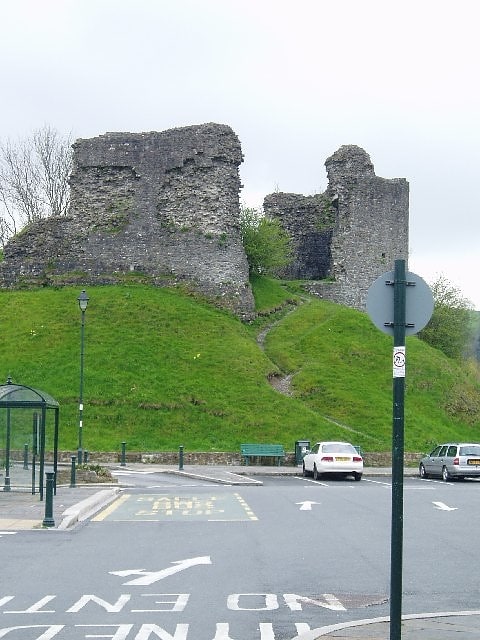
Castle in Llandovery, Wales. Llandovery Castle is a late thirteenth-century, Grade II*-listed, castle ruin in the town of Llandovery in Carmarthenshire, Wales. It occupies a knoll overlooking the River Towy and the land surrounding it. The Normans built a castle in the current location in the early twelfth century and this was rebuilt in stone. It was burnt in the early sixteenth century and never repaired.[2]
St Mary's Church
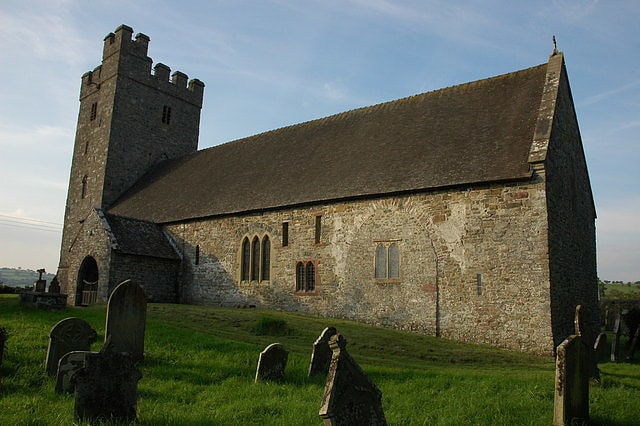
Place of worship in Llandovery, Wales. St Mary's Church is a Church in Wales place of worship near Llandovery, Carmarthenshire, Wales. It was formerly the parish church of Llanfair-ar-y-bryn but was replaced in that function by a new church in a more central location. The present building dates from the 12th century. It has a large churchyard and is situated on a small hill to the north of the town. It was designated a Grade I listed building on 3 August 1966.[3]
Williams Pantycelyn Memorial Chapel
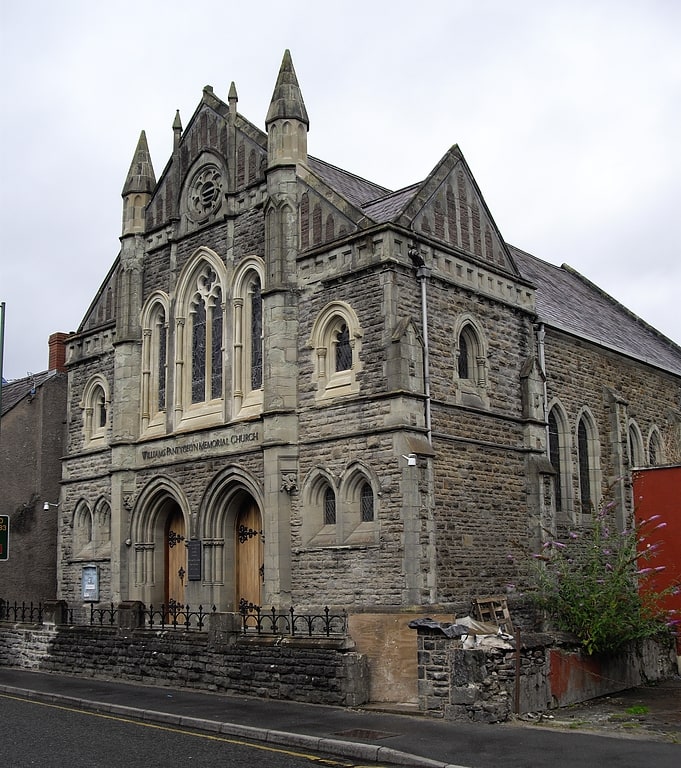
The Williams Pantycelyn Memorial Chapel is a Calvinistic Methodist chapel in the town of Llandovery, Carmarthenshire, Wales. The building was constructed between 1886 and 1888 and is located at 4 Stryd y Bont, Llandovery. It was built as a memorial to the Welsh hymn writer William Williams Pantycelyn.
The Williams Pantycelyn Memorial Chapel was built in 1886 to 1888 after a national appeal had raised £3000. It is built in the Gothic style from grey sandstone with dressings of green Quarella stone from Bridgend. The facade has three bays, pinnacled pilasters and windows with much tracery. The interior has a high hammer beam roof, an apse with a chancel arch. The pulpit is of Caen stone and is embellished with biblical scenes and pieces of text from Williams' work. The main window has fine stained glass depicting David, Isaiah, Miriam and Matthew, installed by Bell of Bristol in 1887.
It was designated as a Grade II*-listed building on 2 January 2000, being a fine example of "an unusually elaborate Gothic chapel designed by a leading Cardiff architect. Fine interior with remarkable amount of figurative detail, including carved pulpit and stained glass. Of historical significance as a memorial to William Williams Pantycelyn, C18 preacher and hymnist".
The Royal Commission on the Ancient and Historical Monuments of Wales curates the archaeological, architectural and historic records for this chapel. These include digital photographs, a collection of old postcards, a Victorian Society South Wales Group Tour Guide, colour slides and items from the Rosser Collection.[4]
Salem Independent Chapel
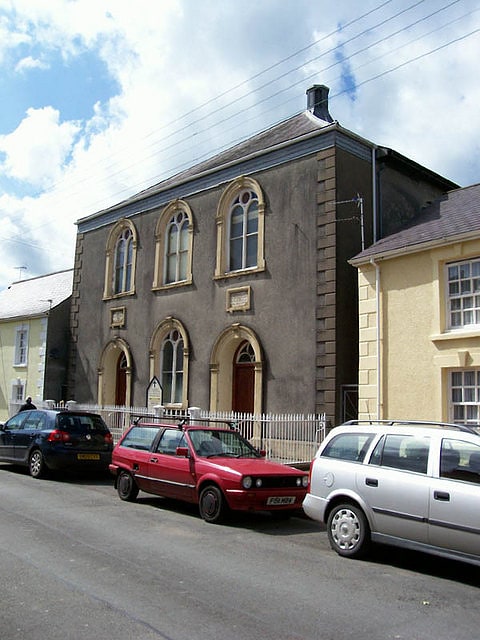
Church in Llandovery, Wales. Salem Independent Chapel is an Independent chapel in the town of Llandovery, Carmarthenshire, Wales. The present building dates from between 1829 and 1830 and is located at Orchard Street, Llandovery. It was designated as a Grade II listed building on 26 February 1981.
Salem Independent Chapel was built between 1829 and 1830 and underwent considerable alterations in the 1870s. The two-storey facade has a raised plinth and quoins, three bays and a pyramidal hipped roof with a truncated front edge. The windows are pilastered and have arched surrounds. There are three windows on the upper storey while the lower storey has a central window and two doors on either side. The interior of the chapel is rectangular in plan and has a single gallery with pilasters dividing up the long panels. This and the pulpit, with its sweeping stair, date to about 1870 and are in the style of the architect Thomas Thomas. The organ gallery dates from 1937, the organ being by the organ-makers Conacher.
Salem Independent Chapel was designated as a Grade II listed building on 26 February 1981, being a fine example of "a substantial pyramid-roofed chapel of 1829 with external and internal detail of 1870s". The Royal Commission on the Ancient and Historical Monuments of Wales curates the archaeological, architectural and historic records for this chapel. These include digital photographs, a collection of old postcards, a Victorian Society South Wales Group Tour Guide and a descriptive account by A.J. Parkinson, dated 18 March 1994.[5]
Ebenezer Baptist Chapel
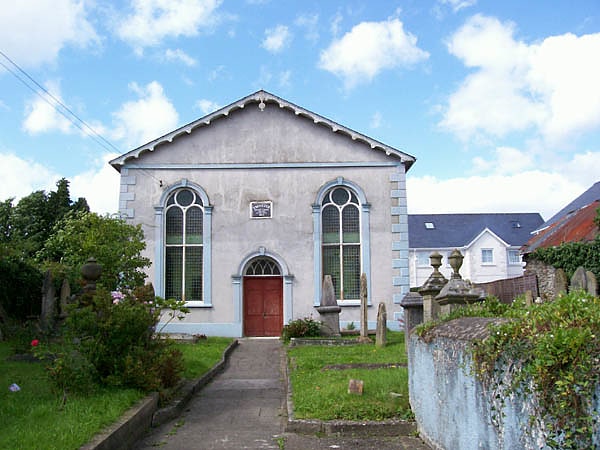
Ebenezer Baptist Chapel is a place of worship in the town of Llandovery, Carmarthenshire, Wales. The building was constructed in 1844 and is located at Gelli Deg, Llandovery. It was built as a sister chapel to Cwmsarnddu Chapel, Cilycwm.
Before Ebenezer Baptist Chapel was built, it is probable that the congregation met in a house in Stone Street. The chapel was built in 1844 and renovated in 1884 to 1885 by George Morgan of Carmarthen, before being extended in 1905 to accommodate more worshippers. The chapel is set back from the road with a long forecourt and faces down the length of Orchard Street. It is a simple, rectangular structure with central double door with pilasters, a moulded arch and keystone. The doors are flanked by tall arched windows with Georgian Gothic tracery to the fanlight, which probably date to 1844. The gable front is roughcast with details in painted stucco. At the rear is an early twentieth century rubble stone annex at the northeast corner of the building, with its door, located at the south end, having a red brick surround.
The interior dates from the 1884 remodelling and includes a three-sided gallery with a double-curved front of pierced cast iron in neo-rococo style. This was probably installed by Macfarlane of Glasgow, and the seven cast-iron columns with scrolled caps that support the gallery are also likely to be his. The organ loft is behind pulpit and is arched, with a panelled and balustraded front. The flat ceiling has a small cornice and ornate plasterwork.
It was designated as a Grade II listed building on 26 February 1981, being a fine example of "a chapel designed as an end stop to a street, with galleried interior".[6]
Llandovery College
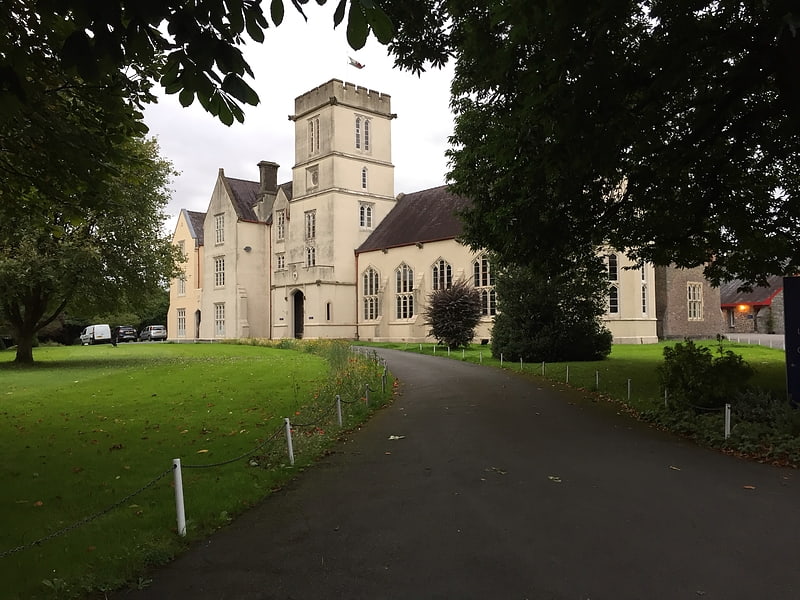
Independent school in Llandovery, Wales. Llandovery College is a coeducational independent boarding and day school in Llandovery, Carmarthenshire, Wales. The college consists of Gollop Preparatory, Senior School and Sixth Form. It was previously known as "Welsh College, Llandovery" and "Collegiate Institute" at various periods of its history.[7]